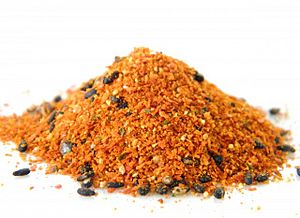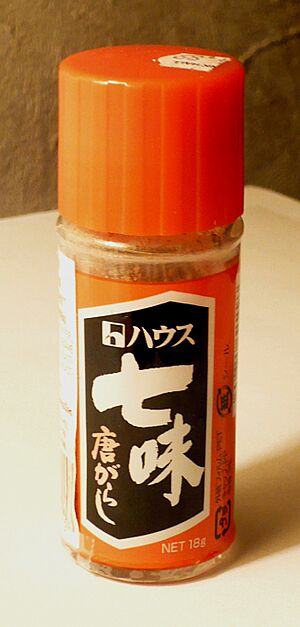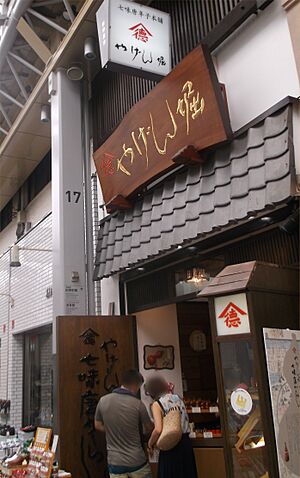Shichimi facts for kids

Shichimi tōgarashi.
|
|
| Alternative names | Nana-iro tōgarashi |
|---|---|
| Type | Spice mixture |
| Place of origin | Japan |
| Invented | 17th century |
Shichimi tōgarashi (pronounced Shee-chee-mee toh-gah-rah-shee) is a popular Japanese spice mix. Its name means "seven-flavor chili pepper" in Japanese. You might also hear it called nana-iro tōgarashi, which means "seven-color chili pepper." It's simply known as shichimi for short. This mix is famous for having seven different ingredients, with chili pepper being the main one that gives it a spicy kick!
Contents
What's in Shichimi?
Shichimi is a special blend of seven different spices. The exact mix can change a little, but here are the common ingredients you'll find:
- Coarsely ground red chili pepper (this is the main spicy part!)
- Ground sanshō (also known as Japanese pepper)
- Roasted orange peel
- Black sesame seeds
- White sesame seeds
- Hemp seeds
- Ground ginger
- Nori or aonori (these are types of seaweed)
- Poppy seeds
Sometimes, other ingredients like yuzu peel (from a Japanese citrus fruit), rapeseed, or shiso (a type of herb) are used instead or added to the mix. Shichimi is different from ichi-mi tōgarashi, which is just plain ground red chili pepper.
How to Use Shichimi
People in Japan often sprinkle shichimi on their food to add flavor and a bit of spice. It's especially popular with:
- Soups
- Noodle dishes
- Gyūdon (a Japanese beef bowl dish)
You can also find it used to season some rice snacks. For example, it's great on rice cakes, agemochi (fried rice cakes), and roasted senbei (rice crackers).
The History of Shichimi
Shichimi has a long history, going back at least to the 1600s! It was first made by herb sellers in a city called Edo, which is now known as Tokyo. Because of its origins, shichimi is sometimes called Yagenbori, named after the place where it was first created.
Today, most shichimi comes from three famous shops, often found near important temples:
- Yagenbori is sold near Sensō-ji Temple.
- Shichimiya is sold near Kiyomizu-dera Temple.
- Yawataya Isogorō is sold near Zenkō-ji Temple.
Shichimi in Japanese Culture
In the past, shichimi was often mixed right in front of the customer, based on what they liked. You could tell the seller exactly what flavors you wanted more of! While most shichimi is now sold pre-mixed in bottles, you can still sometimes see these traditional spice-mixing performances at festivals. It's a fun way to learn about the different ingredients and how they are blended.
Images for kids
See also
 In Spanish: Shichimi para niños
In Spanish: Shichimi para niños




